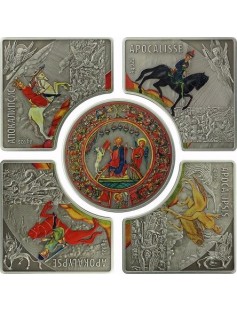- Mintage Limit ONLY - 777
- Each coin in set is struck from 28.28g. of pure silver
- Coin in capsule + with Certificate of Authenticity + BOX
The coin set issue is related to the 2012 phenomenon comprises a range of beliefs according to which cataclysmicor transformative events will occur on 21 December 2012. This date is regarded by some predictions as the final event of history, the ultimate destiny of humanity - commonly referred to as the "end of the world" or "end time". The 21st of December 2012 is the final date of a 5,125-year-long cycle in the Mesoamerican Long Count calendar. Various astronomical alignments and numerological formulae have been proposed as pertaining to this date, though none have been accepted by astronomers or other scientists.
The "Apocalypse" coin set issue represents an optimistic, New Age interpretation of this end-date which means that this date marks the start of time in which Earth and its inhabitants may undergo a positive physical or spiritual transformation, and that 2012 marks a BEGINING of a NEW ERA (as opposition to the end of the human civilization).
The design of the Apocalypse coin set is based therefore on this optimistic vision and presents four Apocalypse horsemen surrounding the Saviour who keeps the divine order of the universe and controls the struggle between good and evil.
Design of the coin set is based on pictures from an illuminated series of manuscripts of St. John Apocalypse (last book of the New Testament - Book of Revelation of Jesus Christ to St. John the Evangelist), written in the 1st half of the 14th century, based on the German text, by Heinrich von Hesler (born in Thuringia, living at the turn of 13th and 14th centuries). The series of illuminated Hesler's Apocalypses was written to order of Luder from Brunswick (being Grand Master of Teutonic Knights between 1331-1335). In this day and age, only three copies from that series survived - the oldest one is kept in the Württembergische Landesbibliothek in Stuttgart (Germany), two others - in the library of the Nicolaus Copernicus University of Torun (Poland).







